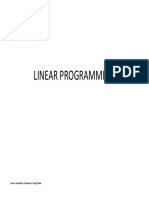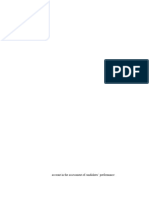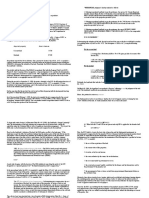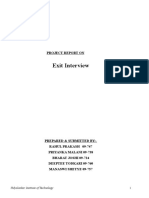Linear Programming - Module
Uploaded by
gijh9727Linear Programming - Module
Uploaded by
gijh9727LINEAR PROGRAMMING
A linear programming model or LP Model is a particular type of mathematical model in
which relationships involving the variables are linear. This model uses a mathematical
technique called linear programming which determines the best or optimal decision even there
are thousands of variables and relationships.
Linear programming has been applied to a wide variety of decision problems in business
and the public sector. The linear programming model is designed to maximize or minimize an
objective function of the form:
f = C1X1 +C2X2 + C3X3 + …+CnXn
where f is same economic objective such as profit, production cost, workweeks or tons
shipped.
Linear programming is two characteristics namely components and assumptions.
Components of Linear Programming Model
1. Objective Function is either maximize or minimize.
2. Decision Variables are assigned to unknown quantities or to the given products/items in the
problem.
3. Constraints are mathematical limitations, relationships expressed in terms of a linear equation
or linear inequalities.
4. Parameters are composed of constants and variables defined in the model.
Assumptions in Linear Programming Model
1. Linearity. This means that the degree of the variable in all linear programming problems
should be always linear.
2. Certainty. This means that you should be certain in all the values that you used to represent
the unknown quantities.
3. Divisibility. This means that non-integer values of the decision values are acceptable.
4. Non-Negativity. This means that non-negative values of the decision variables are not
acceptable.
Formulation of Linear Programming Models
1. Define the specific decision variables.
2. Identify the objective functions which is either to maximize or to minimize.
3. List down the constraints that affect the decision. There are different types of constraints
which can be found on a given word problem such as capacity, market, availability, quality or
blending, production technology or material balance and definitional constraints.
4. Define the specific constraint using the decision variable.
Example 1:
A clock maker makes two types of wood clock to sell at various malls. It takes him three
hours to assemble a pine clock which requires two ounces of varnish. It takes four hours to
assemble a molave clock which takes 4 ounces of varnish. He has eight ounces of varnish
available in stock and he can work for 12 hours. If he makes P100.00 profit on each pine clock
and P120.00 profit on each molave clock, how many of each type should he make to maximize
his profit? Formulate the linear program.
Solution:
1. Decision Variables
Let x be the number of pine clock
y be the number of molave clock
2. Objective Function: Maximize (Profit): P100x + P120y
3. Constraints
Raw materials and process requirements like
- Varnish Requirement
- Processing or Assembly Time
Varnishing : 2x + 4y ≤8
Processing Time : 3x + 4y ≤12
Non-Negativity : x, y ≥ 0
Thus, the linear program would be:
Maximize (Profit): P100x + P120y
Subject to:
Varnishing : 2x + 4y ≤8
Processing Time : 3x + 4y ≤12
x, y ≥ 0
4. Find the feasible region using the x-intercepts and the y-intercepts and make a decision.
Linear Inequalities converted x-intercept y-intercept
into Linear Equations
2x + 4y =8 (4, 0) (0, 2)
3x + 4y =12 (4, 0) (0, 3)
Example 2
A biologist is developing two new strains of bacteria. Each sample of Type A
bacteria produces five new viable bacteria and each Type B bacteria produces six new
viable bacteria. Altogether, at least 150 new viable bacteria must be produced. At least
10 but not more than 20 of the original sample must be Type A and not more than 60 of
the samples must be Type B. A sample of Type A costs P500 and a sample of Type B
costs P700. If both types are to be used, how many surplus of each type should be
used to minimize the cost?
Solution:
1. Decision Variables
Let x be the number of Type A bacteria
y be the number of Type B bacteria
2. Objective Function
Minimize (Cost): P500x + P700y
3. List of Constraints
-amount of new viable bacteria
- limitation on the original Type A and Type B samples of bacteria
Specific Constraints
New Viable Bacteria : 5x + 6y ≥ 150
Original Type A Bacteria : x ≥ 10
Original Type A Bacteria : x ≤ 20
Original Type B Bacteria : y ≤ 60
Non-Negativity : x, y ≥ 0
Thus, the complete linear program would be:
Minimize (Cost): P500x + P700y
Subject to:
New Viable Bacteria : 5x + 6y ≥ 150
Original Type A Bacteria : x ≥ 10
Original Type A Bacteria : x ≤ 20
Original Type B Bacteria : y ≤ 60
Non-Negativity : x, y ≥ 0
4. Find the feasible region using the x-intercepts and the y-intercepts and make a decision.
Linear Inequalities converted x-intercept y-intercept
into Linear Equations
5x + 6y = 150
x = 10
x = 20
y =60
Exercises
1. A tailor has the following materials available: 18 sq meter cotton, 20 sq meter silk, 5 sq
meter wool. A gown requires the following: 3 sq meters cotton, 2 sq meters silk and 1 sq
meter wool. A suit requires the following: 2 sq meter cotton, 4 sq meter silk. If a gown
sells for P1,200.00 and a suit for P1,600.00, how many of each garment should the tailor
make to obtain the maximum amount of money?
Decision Variables:
Let x be the number of gowns
y be the number of suits
Objective Function: Maximize (Profit): P1,200.00x + P1,600.00y
Constraints
Material Requirements
Cotton : 3x + 2y ≤ 18
Silk : 2x + 4y ≤ 20
Wool : x ≤5
x, y ≥ 0
Solution:
2. A drug company produces a drug from two ingredients. Each ingredient contains the
same three antibiotics in different proportions. Each ingredient 1 produced results in
P80 in cost; each ingredient 2 results in P50 in cost. The production of the antibiotics is
dependent on the availability of limited resources. The resources requirements for the
production are as follows:
Antibiotic Resources Requirement Minimum
Ingredient 1 Ingredient 2 Requirement
1 3 units 1 unit 6
2 1 unit 1 unit 4
3 2 units 6 units 12
The company wants to determine the number of grams of each ingredient 1 and
ingredient 2 that must go in to drug in order to meet the antibiotic minimum requirements at the
minimum cost.
SAQ
1. The Alpha Furniture Company manufactures dining room tables and chairs. Each table
requires 50 board feet and 3 hours of labor. Each chair takes 20 board feet and 4 hours of
labor. The manufacturer has 3,000 board feet of lumber available and a staff able to provide
380 hours of labor. Finally, the manufacturer has determined that there is a net profit of P100
for each chair sold and P200 for every table sold. For simplicity, we assume that needed
materials such as nails and varnish are available in sufficient quantities. How many tables and
chairs should the company manufacture in order to maximize its profit assuming that each item
manufactured is sold?
4. The water supply manager for a Midwest city must find a way to supply at least 10 million
gallons of potable water per day (mgd). The supply may be drawn from the local reservoir or
from a pipeline to an adjacent town. The local reservoir has a daily yield of 5 mgd which may
not be exceeded. The pipeline can supply no more than 10 mgd because of its size. On the
other hand, by contractual agreement it must pump out at least 6 mgd. Finally, water reservoir
costs P6,000 for 1 million gallons and pipeline water costs P10,000 for 1 million gallons. How
can the manager minimize daily water costs?
5. A pharmaceutical firm wishes to allocate P50,000 towards advertising in newspapers and
magazines. The intention of the firm is to maximize the exposure of its advertisements. Each
page of the leading newspapers costs P500 and each page of a magazine costs P1,000. It is
guaranteed that each page of the magazine will reach the audience of 250,000 while 50,000
persons will read each page of the newspaper advertisement. Furthermore, it is specified that
at least one page of the magazine and newspaper will be allocated for the firm’s advertisement.
Find the number of pages of magazine and newspaper advertisement that will maximize
exposure and still remain within the P50,000 budget?
You might also like
- A Garment Manufacturer Has A Production Line Making Two Styles of Shirts100% (1)A Garment Manufacturer Has A Production Line Making Two Styles of Shirts2 pages
- Advanced C++ Interview Questions You'll Most Likely Be AskedFrom EverandAdvanced C++ Interview Questions You'll Most Likely Be AskedNo ratings yet
- Formulation of Linear Program Model: Management ScienceNo ratings yetFormulation of Linear Program Model: Management Science25 pages
- Linear Programming: Sources: Quantitative Techniques by Sirug/TabulocNo ratings yetLinear Programming: Sources: Quantitative Techniques by Sirug/Tabuloc48 pages
- Linear Programming: Model Formulation and Graphical SolutionNo ratings yetLinear Programming: Model Formulation and Graphical Solution6 pages
- Lecture Note On Mat 313 Optimization Theory Ii 3unitsNo ratings yetLecture Note On Mat 313 Optimization Theory Ii 3units12 pages
- Module 2: Linear Programming: Model Formulation and Graphical Solution AEC 24: Summer SY 2020 - 2021No ratings yetModule 2: Linear Programming: Model Formulation and Graphical Solution AEC 24: Summer SY 2020 - 202116 pages
- Supplement To Chapter 6: Technological Institute of The PhilippinesNo ratings yetSupplement To Chapter 6: Technological Institute of The Philippines18 pages
- Operations Research - Lecture Five - Linear Programming100% (1)Operations Research - Lecture Five - Linear Programming7 pages
- Solving LP Problems by Graphical SolutionNo ratings yetSolving LP Problems by Graphical Solution12 pages
- AE 106 LP Minimization Graphical MethodNo ratings yetAE 106 LP Minimization Graphical Method25 pages
- Introduction To Quantitative Business Methods: (Do I REALLY Have To Know This Stuff?)No ratings yetIntroduction To Quantitative Business Methods: (Do I REALLY Have To Know This Stuff?)36 pages
- CH 2-1 Linear PP Introduction and Graphic MethodNo ratings yetCH 2-1 Linear PP Introduction and Graphic Method25 pages
- GCSE Mathematics Numerical Crosswords Higher Tier Written for the GCSE 9-1 CourseFrom EverandGCSE Mathematics Numerical Crosswords Higher Tier Written for the GCSE 9-1 CourseNo ratings yet
- Visual Financial Accounting for You: Greatly Modified Chess Positions as Financial and Accounting ConceptsFrom EverandVisual Financial Accounting for You: Greatly Modified Chess Positions as Financial and Accounting ConceptsNo ratings yet
- GPS Based Robot Navigation For Field Mobile Robot PaperNo ratings yetGPS Based Robot Navigation For Field Mobile Robot Paper16 pages
- Secret Key Cryptography Using Graphics CardsNo ratings yetSecret Key Cryptography Using Graphics Cards14 pages
- iHand55-Professional-Field-Controller-EN-20240702No ratings yetiHand55-Professional-Field-Controller-EN-202407022 pages
- OPT101 Monolithic Photodiode and Single-Supply Transimpedance AmplifierNo ratings yetOPT101 Monolithic Photodiode and Single-Supply Transimpedance Amplifier31 pages
- How To Make A Very Simple Savonius Wind Turbine: InstructablesNo ratings yetHow To Make A Very Simple Savonius Wind Turbine: Instructables15 pages
- Revised Strategic Analysis & Recommendations_ Margin Improvement StrategyNo ratings yetRevised Strategic Analysis & Recommendations_ Margin Improvement Strategy7 pages
- "La Caixa"-Severo Ochoa International PHD Programme at The Cnio 2014 CallNo ratings yet"La Caixa"-Severo Ochoa International PHD Programme at The Cnio 2014 Call5 pages
- Albury Line: Via Wangaratta, Benalla and SeymourNo ratings yetAlbury Line: Via Wangaratta, Benalla and Seymour4 pages
























































































